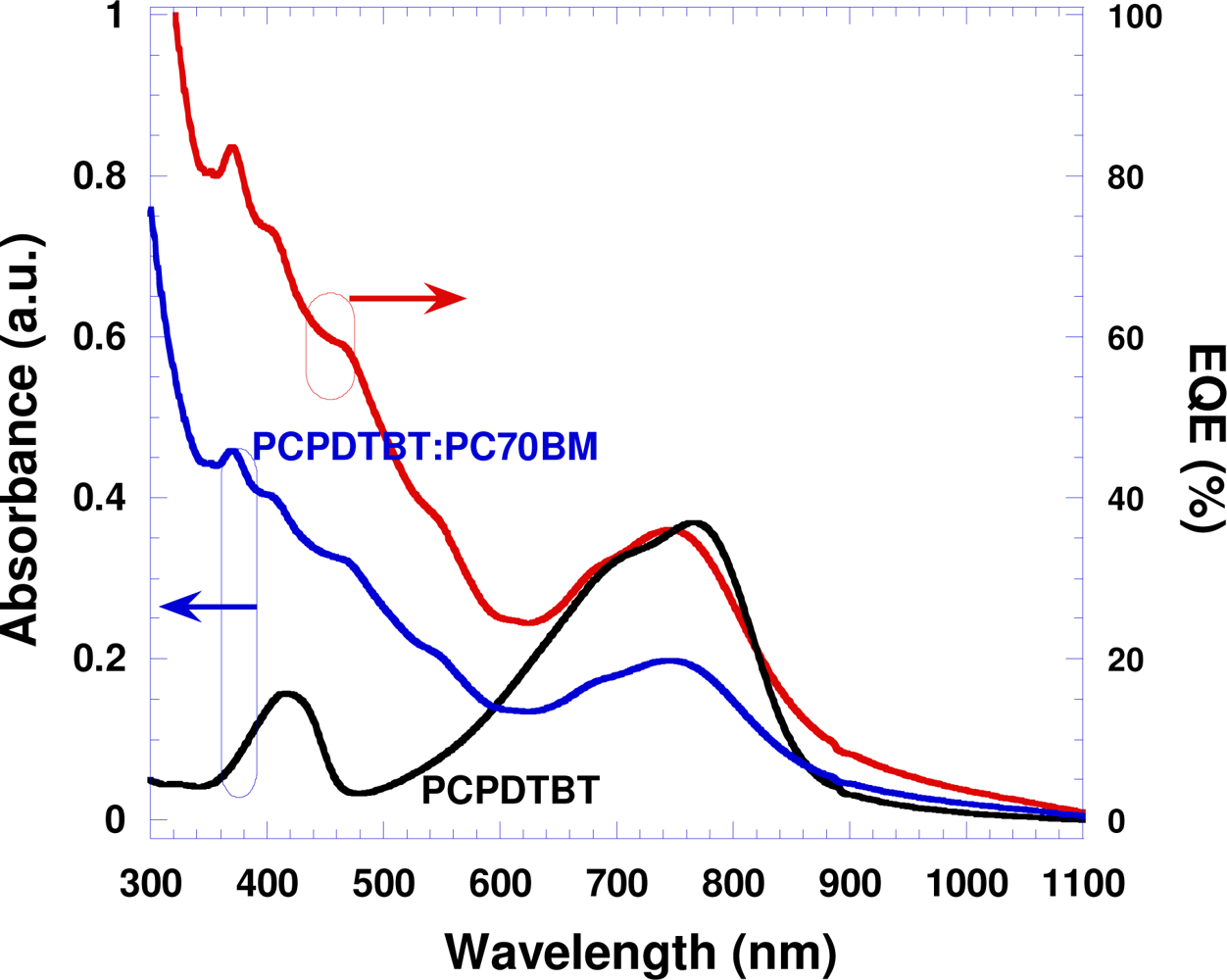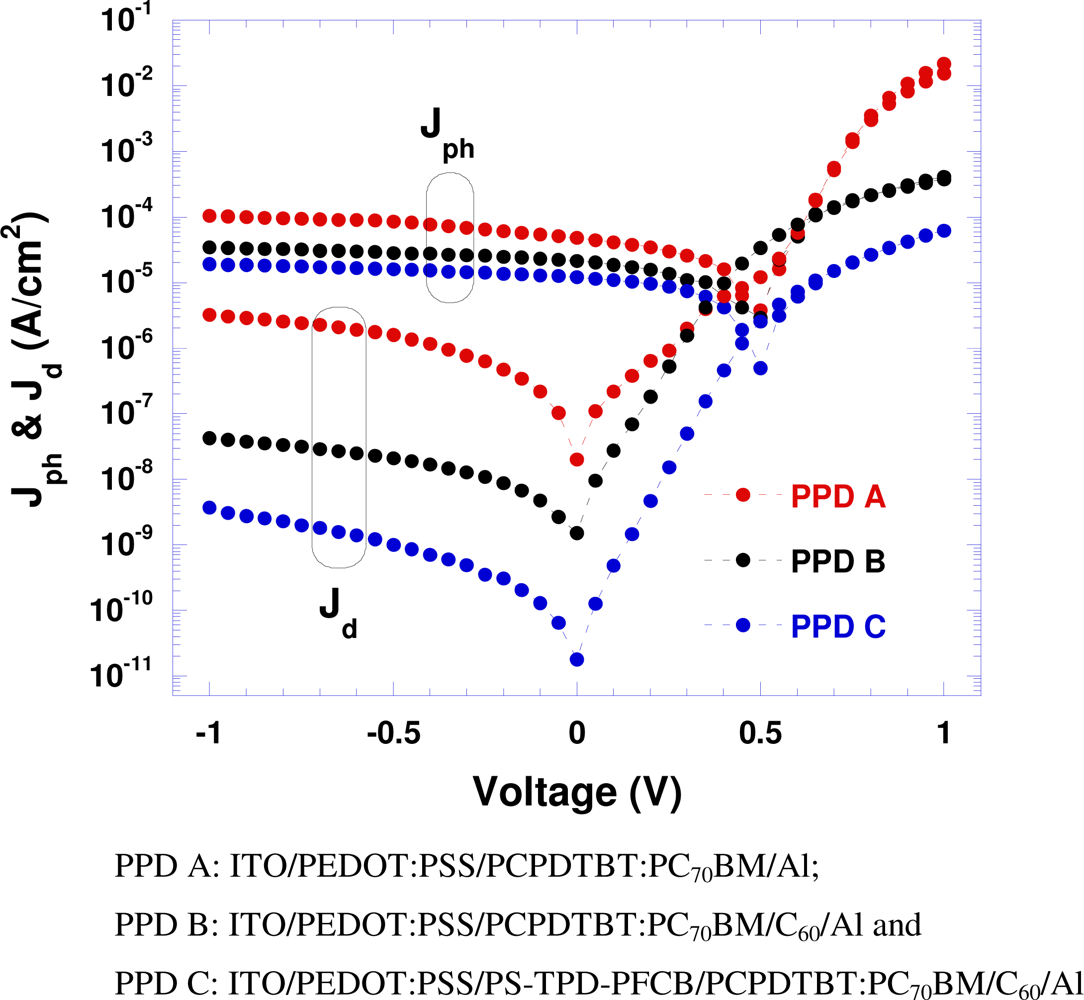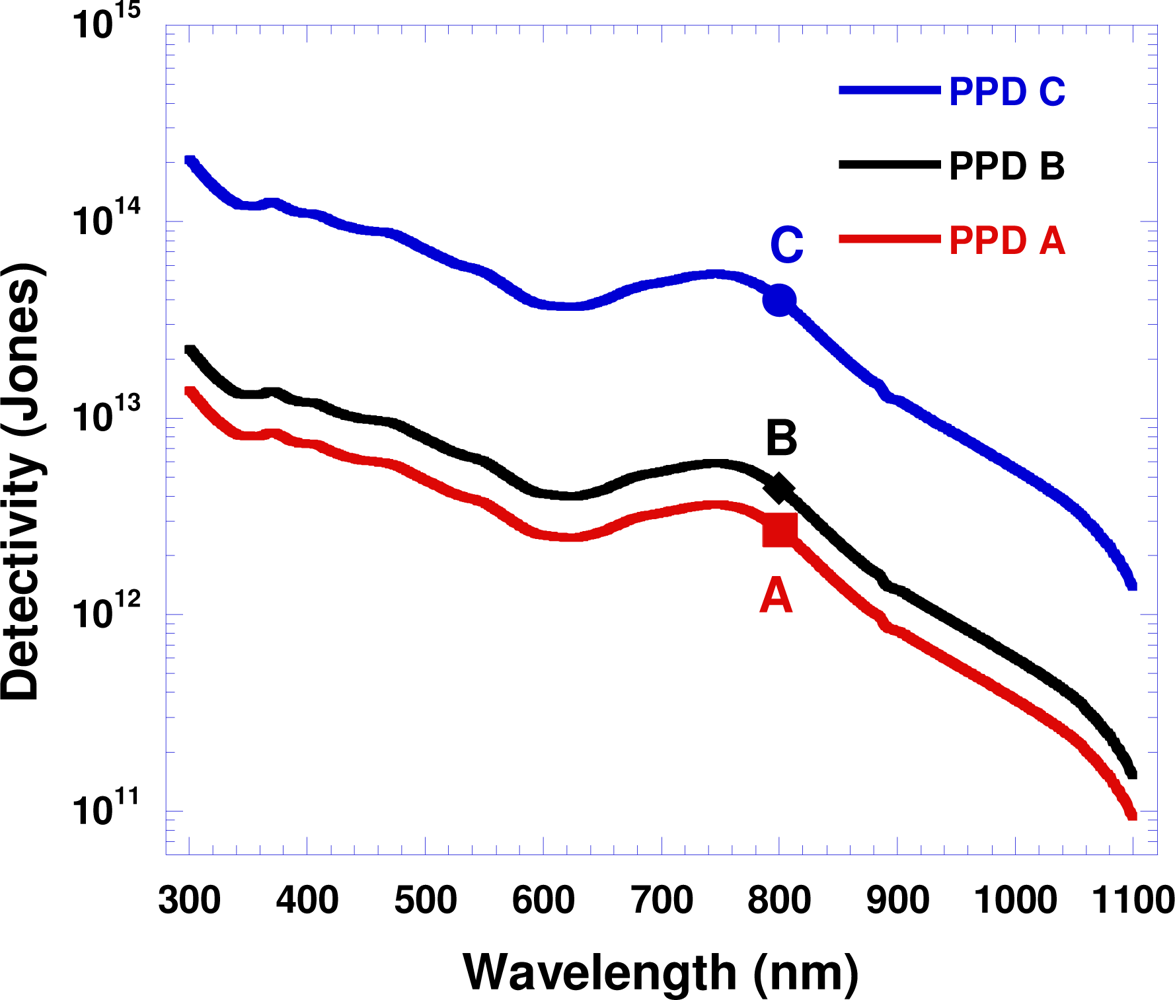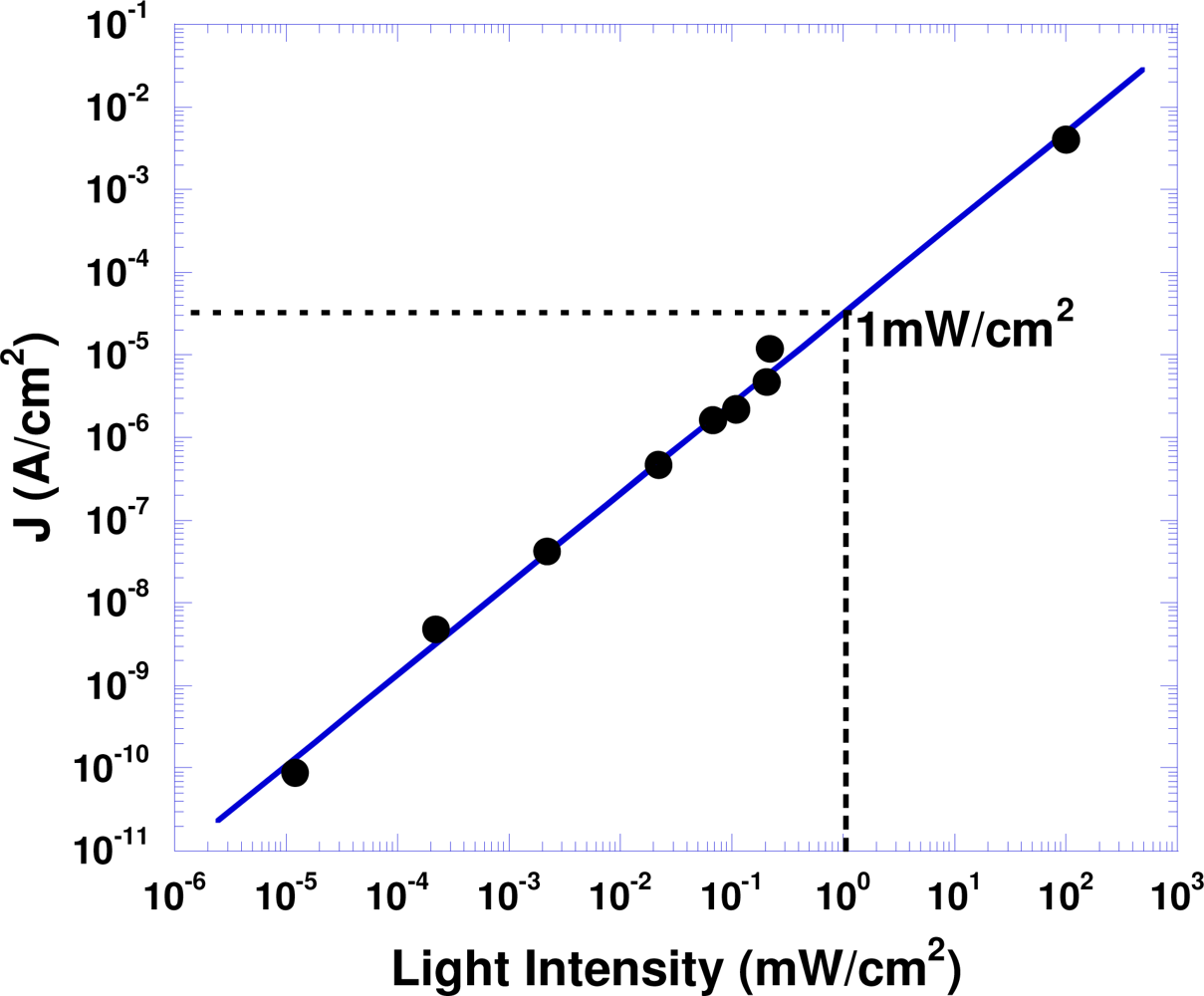Semiconducting Polymer Photodetectors with Electron and Hole Blocking Layers: High Detectivity in the Near-Infrared
Abstract
:1. Introduction
2. Experiment
3. Results and Discussions
- PPD A: ITO/PEDOT:PSS/PCPDTBT: PC70BM/Al;
- PPD B: ITO/PEDOT:PSS/PCPDTBT: PC70BM/C60/Al and
- PPD C: ITO/PEDOT:PSS/PS-TPD-PFCB/PCPDTBT: PC70BM/C60/Al.
Acknowledgments
References
- Rogalski, A; Antoszewski, J; Faraone, L. Third-generation infrared photodetector arrays. J Appl Phys 2009, 105, 091101/1–44. [Google Scholar]
- Ettenberg, M. A little night vision. Adv. Imaging 2005, 20, 29–32. [Google Scholar]
- Kim, S; Lim, YT; Soltesz, E; Grand, A; Lee, J; Nakayama, A; Parker, J; Mihaljevic, T; Laurence, RG; Dor, D; Cohn, L; Bawendi, M; Frangioni, J. Near-infrared fluorescent type II quantum dots for sentinel lymph node mapping. Nature Biotechnol 2003, 22, 93–97. [Google Scholar]
- Jha, AR. Infrared technology; John Wiley & Sons, Inc: New York, NY, USA, 2000; pp. 245–267. [Google Scholar]
- Sargent, EH. Infrared quantum dots. Adv. Mater 2005, 17, 515–522. [Google Scholar] [CrossRef]
- Mcdonald, SA; Konstantatos, G; Zhang, SG; Klem, EJD; Levina, L; Sargent, EH. Solution-processed PbS quantum dot infrared photodectors and photovoltaics. Nat. Mater 2005, 4, 138–142. [Google Scholar] [CrossRef] [PubMed]
- Schilinsky, P; Waldauf, C; Brabec, CJ. Recombination and loss analysis in polythiophene based bulk heterojunction photodetectors. Appl. Phys. Lett 2002, 81, 3885–3887. [Google Scholar] [CrossRef]
- Peumans, P; Bulovic, V; Forrest, SR. Efficient, high-bandwidth organic multiplayer photodetectors. Appl. Phys. Lett 2000, 76, 3855–3867. [Google Scholar] [CrossRef]
- O’Brien, GA; Quinn, AJ; Tanner, DA; Redmond, GA. single polymer nanowire photodetector. Adv. Mater 2006, 18, 2379–2383. [Google Scholar] [CrossRef]
- Gong, X; Tong, MH; Xia, YJ; Cai, WZ; Moon, JS; Cao, Y; Yu, G; Shieh, CL; Nilsson, B; Heeger, AJ. High-detectivity polymer photodetectors with spectral response from 300 nm to 1450 nm. Science 2009, 325, 1665–1667. [Google Scholar] [CrossRef] [PubMed]
- Soci, C; Hwang, IW; Moses, D; Zhu, ZZ; Waller, D; Gaudiana, R; Brabec, CJ; Heeger, AJ. Photoconductivity of a low-bandgap conjugated polymer. Adv. Func. Mater 2007, 17, 632–636. [Google Scholar] [CrossRef]
- Peet, J; Kim, JY; Coates, NE; Ma, WL; Moses, D; Heeger, AJ; Bazan, GC. Efficiency enhancement in low-bandgap polymer solar cells by processing with alkane dithiols. Nat. Mater 2007, 6, 497–500. [Google Scholar] [CrossRef] [PubMed]
- Gong, X; Moses, D; Heeger, AJ; Liu, S; Jen, AKY. High-performance polymer light-emitting diodes fabricated with a polymer hole injection. Appl. Phys. Lett 2003, 83, 183–185. [Google Scholar] [CrossRef]
- Brédas, JL; Beljonne, D; Coropceanu, V; Cornil, J. Charge-transfer and energy-transfer processes in π-conjugated oligomers and polymers: a molecular picture. Chem. Rev 2004, 104, 4971–5004. [Google Scholar] [CrossRef] [PubMed]
- Nelson, J. The Physics of Solar Cells; Imperial College Press: London, UK, 2003; pp. 145–180. [Google Scholar]
- Rostalski, J; Meissner, D. Photocurrent spectroscopy for the investigation of charge carrier generation and transport mechanisms in organic p/n-junction solar cells. Sol. Energy Mater. Sol. Cells 2000, 63, 37–47. [Google Scholar] [CrossRef]
- Chang, YM; Wang, L; Su, WF. Polymer solar cells with poly(3,4-ethylenedioxythiophene) as transparent anode. Organ. Elect 2008, 9, 968–973. [Google Scholar] [CrossRef]
- Wienk, MM; Turbiez, MGR; Struijk, MP; Fonrodona, M; Janssen, RAJ. Low-band gap poly(di-2-thienylthienopyrazine): fullerene solar cells. Appl Phys Lett 2006, 88, 153511/1–3. [Google Scholar]
- Zhang, F; Mammo, W; Andersson, LM; Admassie, S; Andersson, MR; Inganäs, O. Low-bandgap alternating fluorine copolymer/methanofullerene heterojunctions in efficient near-infrared polymer solar cells. Adv. Mater 2006, 18, 2169–2173. [Google Scholar] [CrossRef]
- Mühlbacher, D; Scharber, M; Morana, M; Zhu, Z; Waller, D; Gaudiana, R; Brabec, CJ. High photovoltaic performance of a low-bandgap polymer. Adv. Mater 2006, 18, 2884–2889. [Google Scholar] [CrossRef]
- Yao, Y; Liang, YY; Shrotriya, V; Xiao, SQ; Yu, LP; Yang, Y. Plastic near-infrared photodetectors ultilizing low band gap polymer. Adv. Mater 2007, 19, 3979–3983. [Google Scholar] [CrossRef]
- Bhattacharya, P. Semiconductor Optoelectronics Device; Prentice-Hall, Inc: New Jersey, NJ, USA, 1997; pp. 345–367. [Google Scholar]





© 2010 by the authors licensee MDPI, Basel, Switzerland. This article is an open access article distributed under the terms and conditions of the Creative Commons Attribution license (http://creativecommons.org/licenses/by/3.0/).
Share and Cite
Gong, X.; Tong, M.-H.; Park, S.H.; Liu, M.; Jen, A.; Heeger, A.J. Semiconducting Polymer Photodetectors with Electron and Hole Blocking Layers: High Detectivity in the Near-Infrared. Sensors 2010, 10, 6488-6496. https://doi.org/10.3390/s100706488
Gong X, Tong M-H, Park SH, Liu M, Jen A, Heeger AJ. Semiconducting Polymer Photodetectors with Electron and Hole Blocking Layers: High Detectivity in the Near-Infrared. Sensors. 2010; 10(7):6488-6496. https://doi.org/10.3390/s100706488
Chicago/Turabian StyleGong, Xiong, Ming-Hong Tong, Sung Heum Park, Michelle Liu, Alex Jen, and Alan J. Heeger. 2010. "Semiconducting Polymer Photodetectors with Electron and Hole Blocking Layers: High Detectivity in the Near-Infrared" Sensors 10, no. 7: 6488-6496. https://doi.org/10.3390/s100706488



